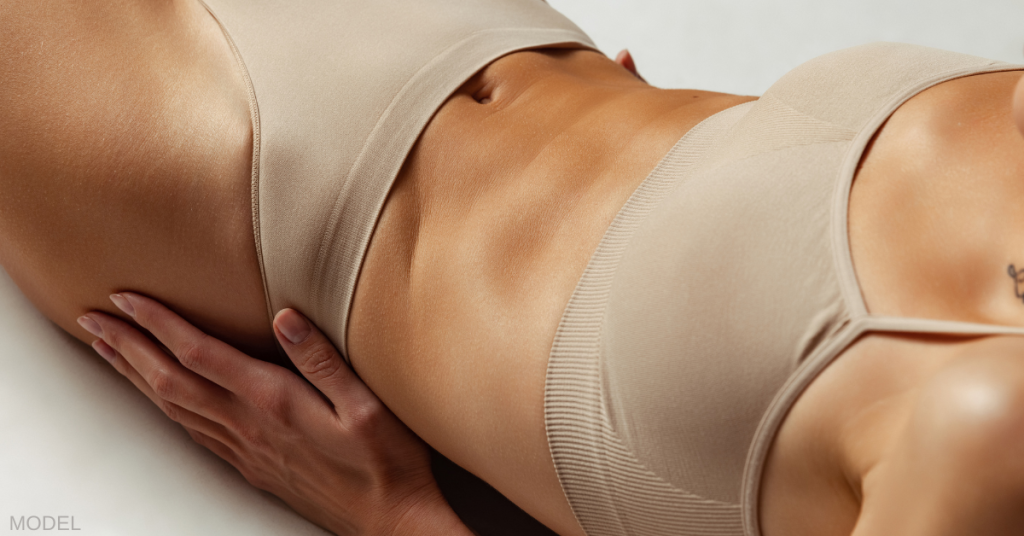Most people considering plastic surgery want natural-looking curves without looking bulgy, artificial, or “overdone.” Fat transfer provides that subtle fullness, contouring your breasts, face, and buttocks using your own excess fat. While fat transfer procedures may not be as common as dermal fillers or breast or buttock augmentation with implants, more people are discovering this versatile procedure and enjoying its many benefits.
So, should you bypass the implants and fillers in favor of buttocks, breast augmentation, or facial fat transfer? The answer to that question depends on your goals and whether they match what fat grafting can achieve. In this post, we discuss the details of each so you know what to expect.
Breast Augmentation Fat Transfer
Like all fat transfer procedures, breast augmentation fat transfer combines liposuction fat removal and cosmetic filling. Typically, fat is removed from a part of the body where there is ample supply, such as the abdomen, buttocks or thighs, and placed in the breasts to create volume. The fat is processed before it’s injected into the breasts.
This procedure using your own fat can make your upper breasts fuller and increase the size of your breasts up to about a cup size. The results are usually subtle, so this procedure is perfect for women who want their breast enhancement results to look and feel natural.
What To Expect
Your plastic surgeon will first harvest fat deposits from a pre-determined area using liposuction. The fat cells are then put in a centrifuge device to remove impurities, put in a syringe, and injected into the breasts using a cannula. Your procedure will typically take 1 to 2 hours, and you will be given a general or local anesthetic.
The purified fat cells must be injected gradually and precisely to achieve the best results, and you may need multiple procedures to achieve the results you want. After the procedure, you will experience some bruising and swelling at both the liposuction and injection sites. But you should be able to return to work and other nonstrenuous daily activities within a week or two.
Choosing a board-certified and experienced plastic surgeon to perform your procedure is vital for safe, effective results.
Fat Transfer to the Buttocks (Brazilian Butt Lift)
Fat grafting is used to perform the popular Brazilian butt lift (BBL). This procedure can give you fuller, rounder buttocks, improving your contours. This procedure uses more fat than many other fat transfer procedures, anywhere from about 600 ml to 1,000 ml, depending on your goals. Your plastic surgeon will determine if you are a good candidate for a BBL.
Is a BBL Procedure Safe?
You may have read or heard questions about the safety of a BBL—not due to the overall fat grafting process but specific to the anatomical region where the fat is injected. The buttocks contain many blood vessels and the large gluteal muscle. If the fat is injected into the muscle, there is a significant risk of blood clots and pulmonary fat embolism. Due to this risk, plastic surgeons changed their techniques when performing a BBL and now inject the fat subcutaneously (above the gluteal muscle rather than in the muscle itself), where it’s safer. They’re also using less flexible cannulas so they can better control the injection site.
A board-certified and experienced plastic surgeon will be well-versed in these safer, advanced techniques, so choosing a knowledgeable, skilled surgeon for your procedure is important.
Facial Fat Transfer
For men and women who want to add natural-looking, longer-lasting volume to their face and lips, facial fat transfer is often a better option than injectable fillers. Facial fat transfer can be used to improve the following concerns.
- Flat cheeks
- Hollows around the eyes
- Folds around the mouth
- Sagging jawline
- Thinning lips
- Facial scarring
Facial fat transfer is also a better option if you are allergic to dermal fillers. However, only about half to two-thirds of the transferred fat will survive the transfer process. The body harmlessly absorbs the fat cells that don’t survive.
Recovery After Facial Fat Grafting
The procedure will take around 1 to 2 hours, and you will typically have minimal downtime. Expect to experience some minor discomfort or mild bruising during the first few days after the procedure. You can use ice packs and pain medication to manage any discomfort. You can resume your regular routine 2 weeks after fat grafting.
You can enjoy your results for several years. Although they may diminish over time due to the natural aging process, fat transfer is ideal for those who want a longer-lasting rejuvenation than dermal fillers can give them.
What Are the Benefits of Fat Grafting?
Using your fat to add volume to various areas of the body offers many benefits, including:
- Softer and more natural-looking results
- Improved contours by removing unwanted fat from trouble spots and adding it where it’s needed
- Enhanced skin appearance (when used for wrinkles and scars)
- Relatively easy recovery (for facial and breast fat transfer)
- Often less expensive than implants or repeated dermal filler procedures
Fat transfer is not for everyone; your plastic surgeon will be the best person to determine if you are a good candidate. Check out some before and after photos of our facial fat grafting patients’ results. To learn more, request a consultation or call us at (859) 277-9435 to schedule an appointment.



Leave a Reply